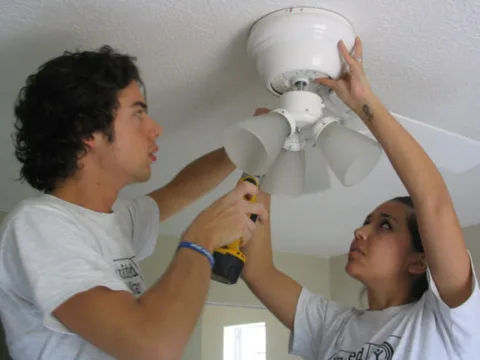Sometimes you don’t realize until after you’ve lived in your house for awhile which rooms you really want (or need) to have ceiling fans in.
Have you ever considered buying ceiling fans for non-traditional rooms like your bathroom or kitchen? I have — especially when cooking in the kitchen and getting ready in my small (and hot) bathroom!
There’s no doubt about it, installing a ceiling fan is a great way to add comfort and value to your home.
Since there are so many different types of ceiling fans, you’ll want to make sure you choose the right one — and the right size — for your needs.
Here are 4 things to know when buying a ceiling fan for your home:
#1 – The Differnce Between Ceiling Fans vs Whole House Fans
Ceiling fans produce completely different results from whole-house fans.
A ceiling fan is usually placed on the ceiling in each room of the house that is frequently occupied – such as a bedroom or living room.
Ceiling fans move air around a single room to make it feel cooler for everyone in that room.
A whole house fan is a large fan that is usually installed in the attic as part of the home’s ventilation system.
Whole house fans circulate air throughout your house by pulling up the warm air and exhausting it out through the roof to keep your entire house cooler.
If you’re looking for a ceiling fan (or two) for specific rooms in your house, then read on.
If you’re looking for a whole-house fan instead, then start here:
#2 – How To Choose The Right Type Of Ceiling Fan
Most residential ceiling fans have 5 blades — the look and shape of which are purely cosmetic. It comes down more to personal preference than what the fan blades are shaped like.
But you should know ahead of time if you want just a ceiling fan or a ceiling fan with lights.
Here are a few types of ceiling fans you might consider for your home:
- Low-Profile: It hugs the ceiling and is the best choice if your home has ceilings that are less than 8 feet tall.
- Energy Star: This fan tends to be 20% to 50% more efficient than traditional ceiling fans and has minimal environmental impact.
- Damp or Wet: If you live in a humid area or have a porch, patio, or sunroom where you want to install a fan, you’ll want to consider a damp or wet ceiling fan.
#3 – How To Choose The Right Size Ceiling Fan
If you choose a ceiling fan that’s too small, the room is not going to be cooled very efficiently. Choose a fan that’s too big, and you could get blasted with too much air for comfort.
The diameter of fan that you buy should be dictated by the size of the room you plan on cooling.
Here are some appropriate ceiling fan sizes based on room size:
- 75 Sq. Ft or Less: < 36-inch ceiling fan
- 144 Sq. Ft or Less: < 42-inch ceiling fan
- 225 Sq. Ft or Less: < 44-inch ceiling fan
- 400 Sq. Ft or Less: < 54-inch ceiling fan
#4 – Why Ceiling Height Is Important
In addition to fan diameter, you also want to consider the height of your ceiling.
This will help you determine how long of a downrod you need. Ideally, your ceiling fan should rest 8 feet off the ground.
- If you have 8 foot ceilings, then you won’t need a downrod — just install the ceiling fan flush to the ceiling.
- If you have tall ceilings, then purchase a downrod of appropriate length to get your fan down to the height you desire.
Don’t forget the angled ceiling adapter if you have a slanted or vaulted ceiling.
Since you probably want to be pleasantly cool during the hotter months of the year, the cost to run your air conditioner and rely exclusively on the AC to cool your home makes ceiling fans a more affordable option.
Ceiling fans are a relatively inexpensive way to stay cool — especially in the rooms they’re installed in.
And now you know exactly what to look for when buying a ceiling fan! So your home will be sufficiently cool in all the right places.
More Ceiling Fan Tips & Installation Guides
In addition to the links I’ve included above, here are some additional resources to help you choose a ceiling fan:
- How To Install A Ceiling Fan
- Save Money On Energy With Ceiling Fans
- How To Choose An Outdoor Ceiling Fan
- Video: How To Wire & Install A Ceiling Fan
- How To Calculate Ceiling Fan Wind Speed
I’m a health nut, a frugal mom, a dog lover, a DIYer, and a gadget girl. Personally, as a post-divorce, working single mom on a budget I have a lot of experiences that I enjoy sharing so others can learn from the things I wish I knew earlier! Professionally, I’ve worked full-time in a variety of marketing, sales, and editing jobs. You can always find me at the corner of Good News & Fun Times as Managing Editor at The Fun Times Guide (32 fun & helpful websites).






